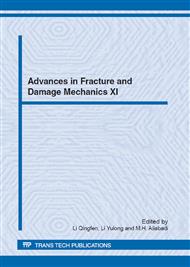p.165
p.169
p.173
p.177
p.181
p.185
p.189
p.193
p.197
Quasi-Static Simulation of Crack Growth in Elastic Materials Considering Internal Boundaries and Interfaces
Abstract:
This work presents numerical methods used for predicting crack paths in technicalstructures based on the theory of linear elastic fracture mechanics. The FE-method is usedin combination with an efficient remeshing algorithm to simulate crack growth. A post pro-cessor providing loading parameters such as the J-integral and stress intensity factors (SIF) ispresented. Path-independent contour integrals are used to avoid special requirements concern-ing crack tip meshing and to enable efficient calculations for domains including interfaces andinternal boundaries. In particular, the interaction of cracks and internal boundaries and inter-faces is investigated. The simulation combines crack propagation within elastic bodies and atbi-material interfaces. The latter is based on a cohesive zone model. The presented numericalresults of crack paths are verified by experiments.
Info:
Periodical:
Pages:
181-184
Citation:
Online since:
November 2012
Authors:
Keywords:
Price:
Сopyright:
© 2013 Trans Tech Publications Ltd. All Rights Reserved
Share:
Citation:


